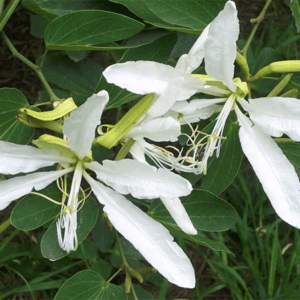The Botanical
 Growing to heights of 5 to 9 meters, Pata de Vaca is found in the rainforests of Peru, Brazil, and tropical zones in Asia, eastern Paraguay, and northeastern Argentina.1 This deciduous to semi-evergreen tree prefers altitudes of 50 to 100 meters and requires 950 to 2,200 millimeters of rainfall annually—conditions which can be found throughout the Ombrofilus Dense Forest (or “Atlantic Forest”) in South America.2
Growing to heights of 5 to 9 meters, Pata de Vaca is found in the rainforests of Peru, Brazil, and tropical zones in Asia, eastern Paraguay, and northeastern Argentina.1 This deciduous to semi-evergreen tree prefers altitudes of 50 to 100 meters and requires 950 to 2,200 millimeters of rainfall annually—conditions which can be found throughout the Ombrofilus Dense Forest (or “Atlantic Forest”) in South America.2
Scientifically, Pata de Vaca is named “Bauhinia forficata” of the leguminosae family. It has a swath of common names including casco de vaca, casco de venado, mororó, pata de boi, unha de boi, unha de vaca, unha-de-anta, and even cow’s foot. The tree itself is sometimes referred to as the Brazilian Orchid Tree because of its beautiful white flowers that resemble orchid blossoms. The genus, “Bauhinia” is named after two brothers, John and Gaspar Bauhin, who were distinguished Botanists of the 16th Century.3
Its leaves are quite distinctive. While only medium-sized at 7 to 10 centimeters in length, the leaves grow in slight V-shapes resembling cows’ hooves. This shape is a striking characteristic of the Bauhinia genus of botanicals.
Health Properties
Traditionally, Pata de Vaca has been sought by locals to serve as a wellness tonic. Studies of the botanical revealed the presence of the flavonoid, kaempferitrin.4
href=”https://pubchem.ncbi.nlm.nih.gov/compound/Kaempferitrin”>https://pubchem.ncbi.nlm.nih.gov/compound/Kaempferitrin.)) Phytochemicals in Pata de Vaca include astragalin, bauhinoside, beta-sitosterol, flavonols, flavonoids, glycosides, guanidine, heteroglycosides, kaempferitrin, organic acids, quercitrosides, rhamnose, and saponins.5
6,Today, the people of South America commonly drink a tea-infused by the leaves of Pata de Vaca after each meal for general health benefits.
Other Uses
The tree itself has been useful for local populations. Because it is fast-growing, the Pata de Vaca tree can be used for reforestation projects and is suitable for populating the first stages of woodland gardens. The wood of the Pata de Vaca tree is heavy, yet has soft and non-durable characteristics when exposed to elements. As such, it can be used in the production of light boxes or other items of light workmanship. At times, whole trunks and branches of the tree are used for fuel and in the production of charcoal.7
Ready to try Pata de Vaca for yourself?
Visit our online store today to add Pata de Vaca to your daily regimen. Our extract contains 35-40% organic alcohol, distilled water, and 100% Pata de Vaca leaf (Bauhinia fortificata). Simply use 10-15 drops once or twice a day in water or as recommended by a health care practitioner.
Learn more and save more!
Stay up-to-date on the latest specials, news, and information from Herbs America. Sign up to receive our newsletter and receive 15% off your first order! CLICK HERE to get started!
Taylor, Leslie. The Healing Power of the Rainforest Herbs, 2005, Text reprinted at: https://rain-tree.com/patadevaca.htm. ↩
Brondani, Gilvano Ebling, Silva, Ariadne Josiane Castoldi, Araujo, Marla Alessandra de, Grossi, Fernando, Wendling, Ivar, & Carpanezzi, Antonio Aparecido. (2008). Phosphorus nutrition in the growth of Bauhinia forficata L. seedlings. Acta Scientiarum. Agronomy, 30(Suppl. spe), 665-671. https://dx.doi.org/10.1590/S1807-86212008000500010 ↩
Sims, John. Curtis’s Botanical Magazine, Or, Flower-garden Displayed: In which the Most Ornamental Foreign Plants, Cultivated in the Open Ground, the Green-house, and the Stove, are Accurately Represented in Their Natural Colours …. United Kingdom: n.p., 1810. ↩
V. Cechinel Filho, Medicinal and Aromatic Plants of South America, Springer Netherlands, 2018, pgs 141-142. ↩
Taylor, Leslie. The Healing Power of the Rainforest Herbs, 2005, Text reprinted at: https://rain-tree.com/patadevaca.htm. ↩
McGuffin, Michael. American Herbal Products Association’s Botanical Safety Handbook, Second Edition. United Kingdom, Taylor & Francis, 2013. ↩
“Bauhinia forficate”, Useful Tropical Plants, http://tropical.theferns.info/viewtropical.php?id=Bauhinia+forficata. ↩

Reader Interactions